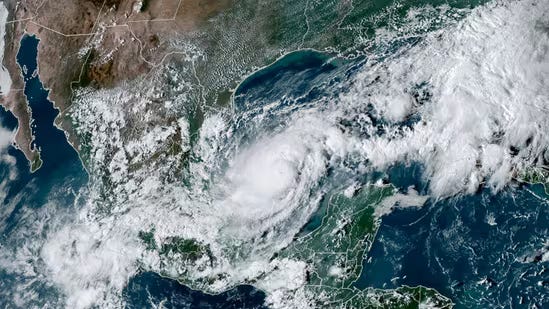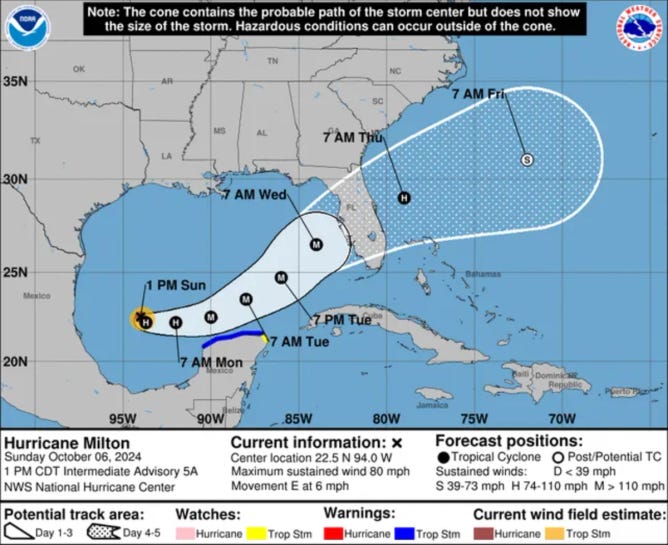Hurricane Milton Powers Up to Category 5: Florida on High Alert Amidst Urgent Preparations
Double Whammy Looms: Areas Devastated by Hurricane Helene Now Brace for Milton’s Wrath.

Hurricane Milton Powers Up to Category 5
As Hurricane Milton barrels through the Gulf of Mexico, it has swiftly evolved into a massive Category 5 storm, setting Florida on a collision course with potentially catastrophic destruction. With sustained winds reaching a staggering 157 mph (250 kph), the storm is on track to become one of the most powerful in recent memory. Just days after Florida’s west coast grappled with the aftermath of Hurricane Helene, Milton’s approach raises alarm bells, as communities still in recovery are bracing for more widespread damage. The stage is now set for one of the most significant evacuation operations in recent Florida history, as officials scramble to prepare for the full force of nature.
Mass Evacuations: A Race Against Time
Governor Ron DeSantis has labelled this the most significant evacuation effort since Hurricane Irma in 2017. Emergency orders have been issued across the state, with tens of thousands of Floridians instructed to evacuate their homes. In Hillsborough County alone, all mobile and manufactured homes have been ordered to be cleared by Tuesday night. "We have no time to lose," DeSantis urged, stressing the importance of swiftly moving people out of the most vulnerable areas.
Lessons from previous disasters like Hurricane Katrina, which claimed over 1,800 lives due to evacuation failures, weigh heavily on the minds of emergency officials. This time, Florida’s preparation efforts are under intense scrutiny. More than 7 million people could be evacuated, and the logistics of managing such an enormous movement of people, especially in a state still dealing with Helene’s destruction, are daunting.
Tampa Bay, Orlando, and surrounding areas have opened city garages for residents to shelter their vehicles from flooding, while schools, including the University of Central Florida, announced closures in anticipation of the storm. Meanwhile, Disney World has suspended road tolls but is continuing operations as normal, although the park's management has said they are closely monitoring the situation.
Storm Surge and Flooding: Florida's Double Whammy
The National Hurricane Center’s forecast predicts a devastating 12-foot (3.6-meter) storm surge in Tampa Bay, a surge that could bring Florida’s western coast to its knees. The potential for flooding, compounded by the significant rain Milton is expected to dump — up to 15 inches (38 cm) in some areas — poses an existential threat to communities across the state.
With Florida’s west coast still grappling with the aftermath of Hurricane Helene, which caused significant flooding and debris, experts warn that Milton’s impact could exacerbate the damage, with debris from Helene potentially becoming dangerous projectiles in the upcoming hurricane-force winds. The mess left behind by Helene must be cleared quickly to avoid a secondary disaster, yet logistical delays, including a locked landfill, have hindered clean-up efforts. "We don't have time for bureaucracy and red tape," said DeSantis, echoing the sentiments of many residents who remain frustrated by the slow recovery from Helene.
Tropical Fury: The Science Behind Milton’s Power Surge
Meteorologists have highlighted the phenomenon of rapid intensification, where storms such as Milton gain extraordinary strength in a short amount of time. Warm waters in the Gulf of Mexico, coupled with favourable atmospheric conditions, have led to Milton’s rapid growth from a tropical storm to a Category 5 hurricane in just a matter of days. These conditions are becoming more common, raising concerns about climate change's role in fuelling more frequent and intense storms.
Experts caution that the 2024 hurricane season could be a bellwether of future climate trends, with increasingly powerful hurricanes threatening coastal regions that are ill-equipped for such sustained battering. The link between rising ocean temperatures and storm intensity is a topic of considerable debate among scientists, but Milton’s emergence stands as a chilling reminder of nature’s unpredictability and fury.
Mexico’s Yucatan Peninsula: Bracing for a Brush with Milton
Florida is not the only region under threat. Mexico’s Yucatan Peninsula, particularly its heavily populated coastal cities like Progreso and Merida, is preparing for a near miss from Hurricane Milton. The Mexican government has issued hurricane warnings and suspended classes in coastal cities, warning of dangerous winds and heavy rainfall. The northern part of the Yucatan, home to a large population and significant economic activities, could see substantial damage from the storm’s outer bands, further complicating disaster management efforts across the Gulf.
Florida's Infrastructure Under Siege: A Test of Resilience
Florida’s emergency response infrastructure is now facing its greatest test since Hurricane Irma. The state has invested heavily in disaster preparedness in recent years, but Milton’s combination of strength, size, and timing makes this a worst-case scenario for the region.
Coastal cities like St. Petersburg and Tampa, which bore the brunt of Helene’s storm surge, are now racing to remove items such as beach chairs, cabanas, and signage that could become airborne in the face of Milton’s Category 5 winds. Local officials have suspended all activities, including beach lifeguard duties, and have evacuated vulnerable populations such as seniors and those with limited mobility.
Florida’s public safety apparatus, including law enforcement and National Guard units, has been deployed en masse to assist with both the clean-up of Helene’s damage and the preparations for Milton. At St. Pete-Clearwater International Airport, flights are being grounded as the airport prepares to shut down. Utility companies are on high alert, preparing for the inevitable power outages that could last for weeks, particularly in low-lying areas prone to flooding.
Economic and Social Costs: The Price of Consecutive Storms
The financial impact of two massive hurricanes hitting the state in quick succession is impossible to ignore. Florida, a major hub for tourism and agriculture, faces billions in losses as Milton barrels towards its shores. Crops that were just beginning to recover from Helene's heavy rains are once again at risk, with farmers scrambling to salvage what they can before the storm hits.
The state’s tourism sector, one of the largest in the country, could also take a significant hit. With evacuations and closures extending through the week, major tourist attractions like Disney World, Universal Studios, and others stand to lose millions in revenue. Airlines are cancelling flights, and ports are shutting down as the storm surge threatens to flood key transportation hubs.
While Florida has seen its share of hurricanes, the back-to-back nature of Helene and Milton, along with the sheer power of these storms, makes this an unprecedented challenge for both the state's economy and its people. The long-term implications are significant: increased insurance premiums, federal disaster aid, and the strain on public services all loom as challenges that will stretch far beyond the storms' immediate aftermath.
In Summary: The Calm Before the Storm
With Hurricane Milton set to make landfall, Florida's population is living in anticipation of yet another potentially deadly storm. The lessons from Helene are fresh in everyone's minds, and this time, both officials and residents are taking every possible precaution. However, the sheer unpredictability of nature’s power leaves a sense of unease across the state.
Florida’s resilience will once again be tested, not just in the immediate aftermath, but in the long road to recovery that lies ahead. As the storm looms, the state's preparedness and response mechanisms are being pushed to their limits, and the coming days will reveal just how well Florida can weather the storm.




